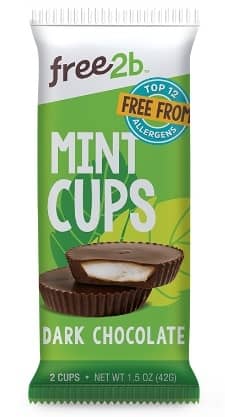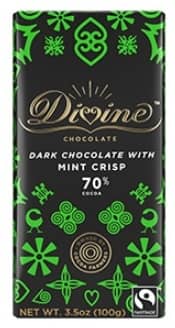Andes Chocolate Mints are the small rectangle-shaped candies with a mint-green fondant layer sandwiched between two layers of chocolate. Junior Mints are small rounds of mint fondant in a dark chocolate coating. Both are made by Tootsie Roll Inc. and have been around for quite some time.
Are Andes Mints vegan? No, Andes Mints are far from vegan. They contain a number of animal-derived ingredients, most being milk-based.
Are Junior Mints vegan? Junior Mints may be considered technically vegan by some. Other vegans consider them non-vegan as they contain confectioner’s glaze which is composed, in part, by a resin substance secreted by female lac bugs.
Quick note: if you’re in a rush, the absolute best vegan alternative to both Andes and Junior mints can be found here. I’ve tried them and the taste is basically indistinguishable from the original, and the quality of ingredients is much higher. And, they do not contain confectioner’s glaze, milk products, or any other non-vegan ingredients.
As for the confectioner’s glaze, not all vegans avoid the stuff given that it’s so ubiquitous and is even used to replace the natural wax on apples (a food product most vegans eat). More on this below.
I personally think it’s wise to stay away from the stuff, as insects are likely killed in large quantities when the “sticklac” is scrapped from tree branches.
Ingredients
Ingredients for Andes Mints include:1
- Sugar
- Partially Hydrogenated Vegetable Oils (Palm Kernel & Palm)
- Cocoa (Processed W/Alkali)
- Nonfat Milk
- Lactose
- Milk Protein Concentrate
- Soy Lecithin (An Emulsifier)
- Natural & Artificial Flavors
- Peppermint Oil
- Colors Added (Yellow 5 Lake, Blue 1 Lake).
Ingredients for Junior Mints Include:2
- Sugar
- Semi-Sweet Chocolate (Sugar, Chocolate Processed with Alkali, Cocoa Butter, Soy
- Lecithin-An Emulsifier, Vanillin-An Artificial Flavor)
- Corn Syrup
- Confectioner’s Glaze
- Food Starch-Modified
- Peppermint Oil
- Invertase (An Enzyme)
The Vegan Status of Ingredients in Andes Mints and Junior Mints
Mint Fondant (Andes Mints and Junior Mints)
Fondant is a crystalline candy (a candy with a homogenous structure) that’s made from a sugar syrup crystallized into a white, creamy paste. It composes the soft, rich filling found in many chocolates, candy bars, and mints.3
It is also used as an icing to decorate and glaze pastries, increasing their visual appeal while sealing off baked products from air and moisture loss.4
Is it vegan? In its most basic form, fondant is considered vegan as it mainly contains sugar (e.g. glucose) combined with water and a little corn syrup or cream of tartar.14
It’s cooked to 234°F–240°F (112°C–115°C) or what’s known as the soft ball stage. When the correct temperature is reached, the candy is mixed until it becomes creamy and white. It’s characteristic consistency and color come from the formation of fine, uniform crystals.15
It’s understandable that this ingredient is often thought to be non-vegan. It has such a fluffy texture that it could definitely make one wonder whether there’s any egg white whipped into the mix.
But, fondant is a crystalline candy which is a class of candies wherein small crystals form with the appearance of many nuclei. The process allows less time for sugar molecules to coalesce around the nuclei, which divides the available sugar molecules among a larger number of nuclei. Ultimately, this means fewer sugar molecules aggregate around each nucleus.
This results in the smooth creamy texture characteristic of fondant and other crystalline candy.3
So, the fact that mint fondant itself is vegan means that it should be fairly easy to find vegan versions of mint chocolate candy (more on that below).
Milk Products (Andes Mints)
Milk chocolate is obviously off-limits for vegans and Andes Mints are loaded with milk products.
First, there’s dry milk which improves flavor and mouthfeel but extends shelf-life compared to non-dry milk.
Milk protein concentrate (whey and casein) is also used. Milk proteins are found in a lot of processed foods to improve their nutritional value.5
Certain proteins like caseinates contribute to stabilization and emulsification of the ingredients. Whey protein contributes to texture and gelling.
Then there’s lactose, the simple sugar found in milk. Most folks know that lactose is commonly found in frozen desserts, but it’s also a popular ingredient in confectionary.5
So overall, milk contributes to Andes Mints by improving texture, moisture, emulsification and flavor.
Confectioner’s Glaze (Junior Mints)
Pharmaceutical glaze or confectioner’s glaze is an alcohol-based mixture of food-grade shellac.6
Shellac is a resin secreted on trees by lac bugs. It’s derived from a material known as sticklac, a resin scraped off of tree branches for use in various food and non-food products.7
The female lac bug, Kerria lacca, sucks up tree sap and secretes a substance called sticklac to form tunnel-like tubes to traverse tree branches. The mini structures are often referred to as cocoons, though they’re not considered cocoons in the entomological sense.8
It’s harvested from bugs so it’s definitely a form of animal exploitation. It’s estimated to take anywhere from 50,000 to 300,000 bugs to produce a single kilogram (2.2 lb) of shellac.9-11
The raw shellac, once harvested, contains crushed lac bugs that were removed during scraping. The mixture is placed in canvas tubes and heated for a time causing the shellac to liquefy and seep through the canvas.
It’s then dried into a flat sheet and made into “buttons” (cakes/pucks) or flakes and eventually crushed into a fine powder.
Is it vegan? It’s safe to say that shellac itself is not vegan. But, vegans will disagree as to whether eating products containing the stuff would render a person non-vegan given that it is used in everyday products and is even put on the surfaces of fruits and vegetables to help improve their visual appeal.
It’s just my opinion, but Junior Mints are hardly a staple in the diet and as long as there are vegan alternatives to the product, it makes sense to go with versions of the candy that don’t contain the stuff.
Vegan Alternative to Andes Mints and Junior Mints
Junior Mints were so close to being completely vegan-friendly. They’re covered in dark chocolate and free of milk products.
For those of you who want to avoid shellac in your candy, I’ll list a couple of vegan-friendly mint chocolate candies.
They may not be exact replacements, but they are really really good. Even better than Andes and Juniors, IMO.
Free2b Dark Chocolate Mint Cups

Ingredients include:12
- Cocoa Mass
- Sugar
- Cocoa Butter
- Organic Powdered Sugar (Evaporated Cane Juice, Tapioca Starch)
- Organic Horchata Blended (Filtered Water, Organic Chufa Seed, Organic Lemon, Sea Salt)
- Organic Peppermint Oil (Sunflower Oil, Peppermint Oil)
- Cocoa Butter
- Water
Divine Chocolate 70% Mint Dark Chocolate Bar

You can find these here.
Ingredients include:13
- Cocoa mass
- Sugar
- Cocoa butter
- Peppermint crisp 5% (sugar, peppermint oil)
- Sunflower lecithin (emulsifier)
- Peppermint oil
- Vanilla
Anyway, that pretty much wraps it up for Andes and Junior Mints. Thanks for reading.
You may also want to check out the following related articles:
- Are Tootsie Rolls Vegan? What About Tootsie Pops?
- Are Swedish Fish Vegan? The Bottom Line
- Are Dum Dums Vegan?
- List of Vegan-Friendly NOW and LATER Flavors
- Is Mike and Ike Candy Really Vegan?
- Are SweeTarts Vegan?
- Are Jolly Ranchers Vegan?
- Are Macarons and Macaroons Vegan?
- Is Store-Bought Granola Vegan?
References
- Tootsie Roll Inc. https://tootsie.com/candy/andes/andes-mints
- Tootsie Roll Inc. https://www.tootsie.com/candy/junior-mints/junior-mints
- Understanding Food: Principles and Preparation (Page 522). Amy Brown – Wadsworth Cengage Learning – 2011
- Friberg B. The Professional Pastry Chef. Van Nostrand Reinhold, 1996.
- Understanding Food: Principles and Preparation (Page 221). Amy Brown – Wadsworth Cengage Learning – 2011
- Smolinske, Susan C. (1992). Handbook of Food, Drug, and Cosmetic Excipients. CRC Press. p. 347. ISBN 0-8493-3585-X.
- Flinn, Angel. “Shellac and Food Glaze” http://gentleworld.org/shellac-food-glaze/
- Shellac, WoodworkDetails.com: Shellac as a Woodworking Finish. http://www.woodworkdetails.com/knowledge/finishing/shellac
- Bangali Baboo; D. N. Goswami (2010). Processing, Chemistry and Application of Lac. New Delhi, India: Chandu Press. p. 4.
- Yacoubou, Jeanne (30 November 2010). “Q & A on Shellac”. Vegetarian Resource Group. http://www.vrg.org/blog/2010/11/30/q-a-on-shellac/
- Velji, Vijay (2010). “Shellac Origins and Manufacture”. shellacfinishes.com. https://www.youtube.com/watch?v=lQcQ0yuekZ0&t=5m23s
- Dark Chocolate Mint Cups. https://thrivemarket.com/p/free2b-dark-chocolate-mint-cups
- 70% Mint Dark Chocolate Bar. https://thrivemarket.com/p/divine-chocolate-70-mint-dark-chocolate-bar
- Understanding Food: Principles and Preparation (Page 523). Amy Brown – Wadsworth Cengage Learning – 2011
- Malgieris N. Nick Malgieri’s Perfect Pastry. Macmillan, 1989.

